Soba Noodles
Soba noodles will be noodles made of buckwheat flour, generally as thick as spaghetti, and arranged in different hot and cold dishes. These dishes are famous and effectively accessible cross country. As 100% buckwheat soba noodles will, in general, be fragile, numerous cafés include some wheat flour while setting up their noodles. Contingent upon the shop, the buckwheat flour level in these noodles regularly runs between 40% and 100%.
Likewise, a couple of noodle dishes named soba (such as Yakisoba, Chukasoba, or Okinawa)can not be complete with buckwheat noodles. Usually, in any case, “soba” alludes to buckwheat noodles.
The most fundamental soba dish is Mori soba, which bubbled, cold, soba noodles use with a soya-based plunging sauce ( Tsuyu ). Numerous soba dishes had consistently, while others are just accessible occasionally. An uncommon sort of dish is Toshikoshi Soba, an image of life span just eaten on New Year’s Eve.
Like pasta, these noodles are accessible in dried structure in grocery stores, yet they taste best if newly made by hand from flour and water. For some time, soba making has been a well known, hands-on action for homegrown and global voyagers. Many art towns and travel visit organizations helped by the movement.
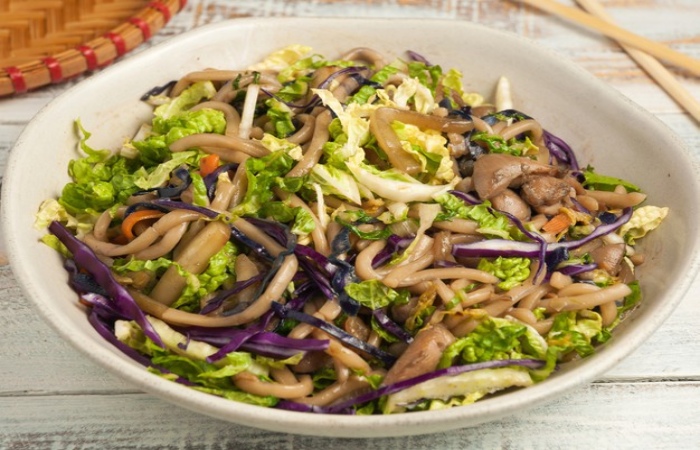
What Are Soba Noodles?
The noodles are produced using buckwheat flour and wheat flour and have a somewhat nutty, hearty sense of taste.
Soba is the Japanese name for buckwheat, with buckwheat noodles being higher in protein and fiber than numerous noodles. In the same way as other Japanese fixings, they have refreshing characteristics as well. They appeared to help direct glucose, improve heart well-being, help with aggravation, and potentially help prevent disease.
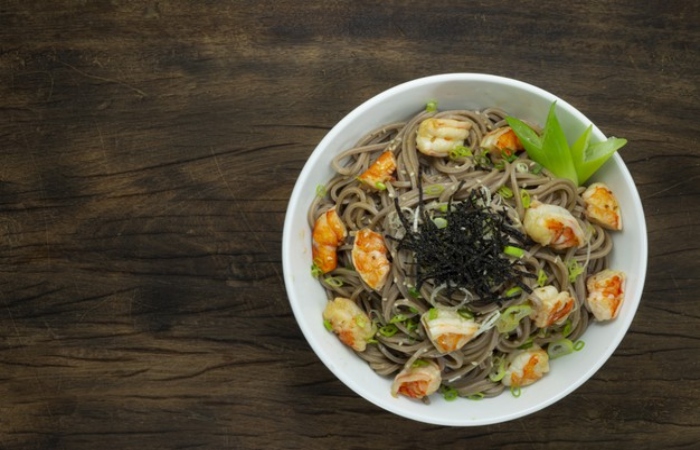
Famous Soba dishes
Soba can serve either hot or cold. The following are a portion of the more normal assortments travelers will experience. Note that a few dishes are well-known under various names relying upon the district.
9 Brilliant Soba Noodle Dishes
1. Mori/Zaru Soba (cold)
The essential sort of chilled soba served on a plate with a basic chilled plunging sauce ( Tsuyu ) served as an afterthought. The plunging sauce is usually a blend of soup stock, water, and mirin. There are verifiable contrasts among Zaru and Mori. Anyway, lately, one significant distinction between the two is Zaru has nori kelp on the soba noodles’ head while Mori doesn’t.
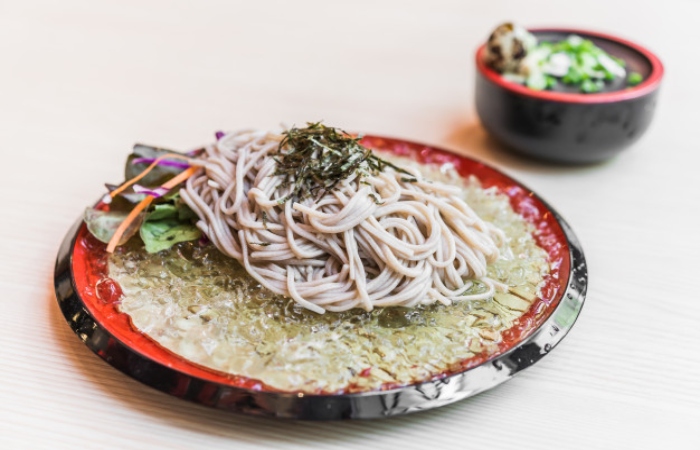
2. Kake Soba ( hot )
These noodles are served in a hot bowl, clear stock. The stock is prepared of similar parts as the plunging sauce for the chilled soba, however, in a lower fixation.
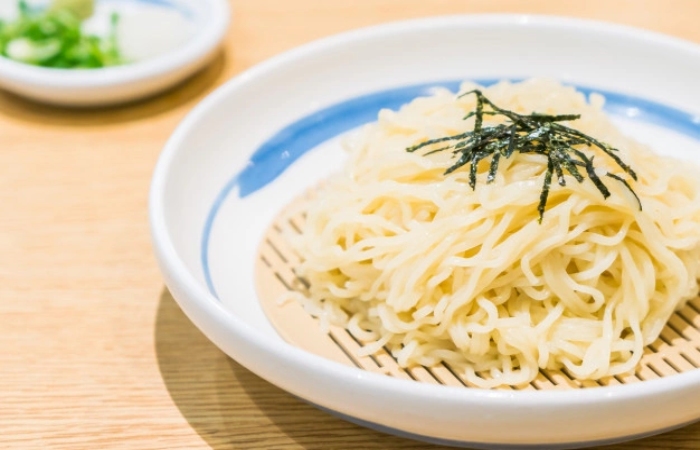
3. Kitsune Soba (hot/cold)
Kitsune Soba accompanies a bit of aburaage, dainty sheets of seared tofu, head of the soba noodles. When in Osaka, if you needed soba with a bit of aburaage on top, you should request Tanuki.
4. Tanuki (hot/cold)
Tanuki made with the aiding of Tenkasu, crunchy pieces of extra singed tempura hitter. In Osaka, the equivalent soba with the aiding of Tenkasu, also known as Haikara Soba.
5. Tempura (hot/cold)
This dish accompanies a serving of tempura either as an afterthought or on the noodles’ head. There are typically three to five various types of tempura pieces, and the fixings differ from shop to shop. The noodles are served either on a plate (as in the photograph) or in a soup.
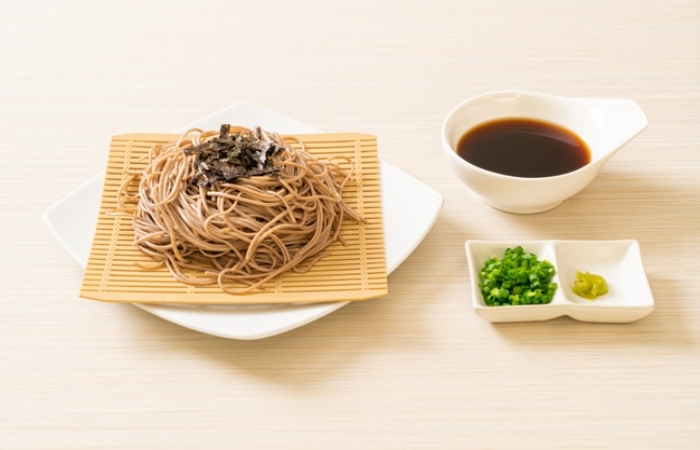
6. Tsukimi Soba (hot)
The strict interpretation of Tsukimi is “moon viewing,” and subsequently, Tsukimi has a crude egg which should look like the moon.
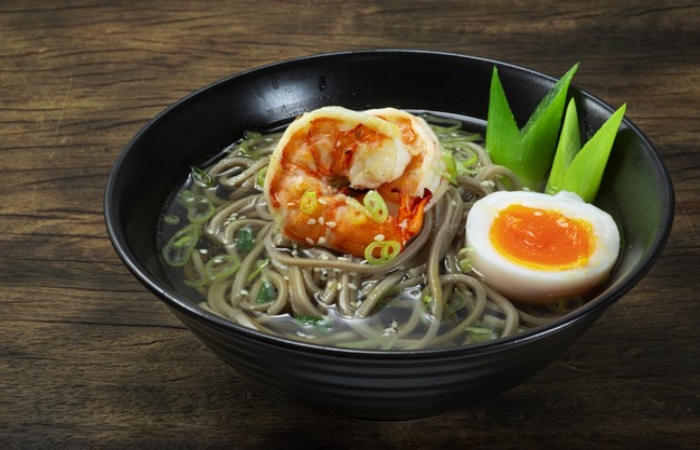
7. Tororo (hot/cold)
Tororo is a white, clingy, glue-like cream made of ground crude nagaimo (sweet potato). It is usually placed on the noodles’ head.
(or)served as an afterthought to be added to the visitor.
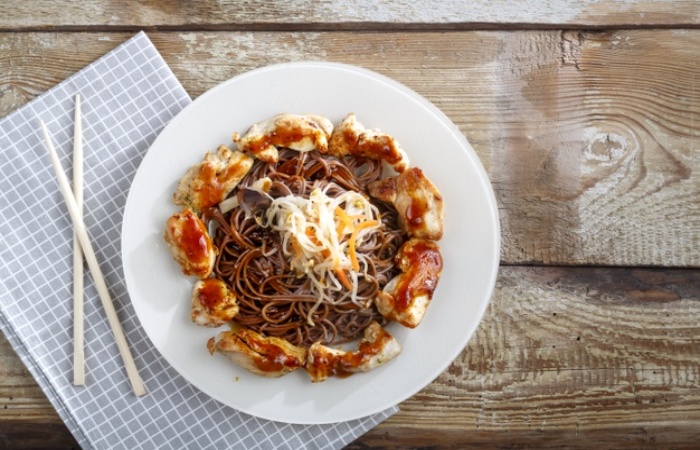
8. Sansai Soba (hot)
Sansai offered cooked Sansai (wild vegetables) put on the noodles’ head in the stock.
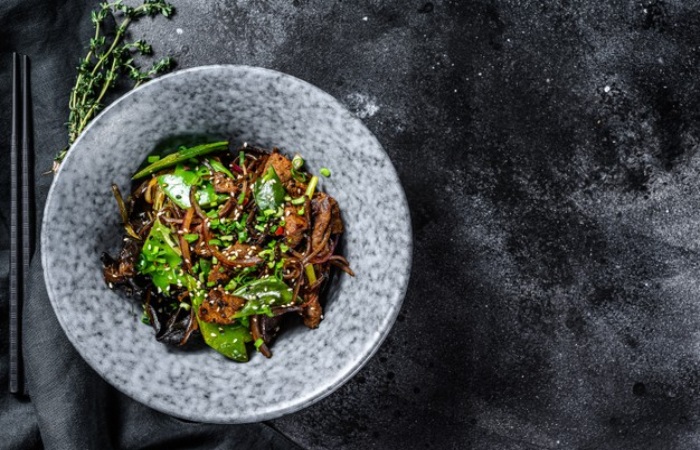
9. Nanban (hot)
Nanban usually alludes to stock that has leek added to it. On most occasions, Nanban has either chicken or duck in reserve, and the incorporation of meat is likewise considered the menu, such as Tori Nanban (chicken) and Kamo Nanban (duck).
They’re an extraordinary motivation to think carefully.
Instructions to Eat Soba
Contingent upon how your soba served, the method of eating contrasts:
- Soba served in a soup (as a rule, the hot ones) are appreciated by utilizing the chopsticks to lead the noodles and making a slurping sound into your mouth. The slurping upgrades the flavors and assists cool with bringing down the hot noodles as they enter your mouth. The stock is flushed legitimately from the bowl, wiping out the requirement for a spoon. It isn’t viewed as discourteous to leave some incomplete soup in the bowl toward the feast’s finish.
- For soba presented with a plunging sauce (for the most part, the cool ones), there are a couple of more strides before you can appreciate them. To start with, blend a portion of the green onions and wasabi into the plunging sauce. At that point, please take a couple of strands of noodles and plunge them into the sauce before eating them.
- Besides, if your soba is offered with a plunging sauce, some soba cafés will give you a little tea kettle towards the feast’s finish that loaded up with what resembles hot shady water. It is Sobayu, the water that the soba noodles cooked in. However, Sobayu intended to immersed your remaining plunging sauce after you have completed your noodles. This way, you can achieve your plunging sauce by drinking this blend and altering the measure of soba yu as you like.
The most effective method to Cook Soba Noodles
Soba noodles top served, basically. Besides, they don’t require creamy sauces or convoluted fixings to dress them up. In addition to sincerity in servings, it likewise as acceptable served cold as it is hot.
Furthermore, these noodles do not take time to cook and are best made. However, still somewhat firm to keep their marginally natural bite. A couple of moments of bubbling time is all you truly need.
In contrast to traditional pasta noodles, these noodles require a wash or two in chilly water to eliminate the gluten and starches delivered while cooking, so they don’t transform into mush.
Sesame Soba Noodles
This Japanese Sesame Soba Noodles formula makes a straightforward Asian side dish. A simple principle dinner on the table also served hot or cold in a short time or less.
This Sesame Noodle formula ticks the entirety of our preferred procedure making boxes. Besides, It’s quick. It is simple and solid. It’s tasty. What’s more, it goes with so a significant number of our preferred mains, and it even makes a primary dinner all in itself.

Instructions to Make Sesame Soba Noodles
Like any noodle formula, it comes down to the aromatics and the sauce to give a plain noodle it’s flavor. What’s more, once more, with soba, you need to keep things straightforward. Also, that implies a specific sauce is altogether.
The elements for this sauce are:
- Soy sauce (I utilized Kroger’s HemisFares Double Fermented Soy Sauce for its exceptional quality)
- Sesame oil
- Rice vinegar
- Sugar
- Newly ground dark pepper
- Toasted sesame seeds (I utilized a blend of white and dark seeds)
The sauce meets up snappy, much the same as the cooking of the noodles. However, if you like a spicier nibble, include a spot of red pepper chips or 1/4 teaspoon of bean stew garlic sauce to the blend.
With regards to sesame oil, be sure yours is new. Sesame oil has a short usability period and will fall apart in quality once opened if not put away accurately. I keep mine in the fridge yet consistently have a new suppress as a back in my storeroom.
To toast your sesame seeds, utilize a dry dish over medium-high warmth. Move the seeds around regularly in the bowl to abstain from consuming. And also, try not to avoid this progression; it toasting effects.
Sesame Soba Noodles
This noodle side dish is heavenly, close by meats and fish. However, it makes an incredible noodle bowl or light lunch with destroyed cabbage, carrots, bean fledglings, and more. And also shockingly better, you can serve it hot or cold.
Course: Side Dish
Food: Japanese
Watchword: Soba
Planning Time:10 minutes
Cook Time:10 minutes
All out Time:20 minutes
Calories: 294 kcal
Servings: 6 persons
Ingredients :
- Ten ounces of HemisFares Air-Dried Buckwheat Noodles
- 1/3 cup of HemisFares Double Fermented Soy Sauce
- Two tablespoons rice vinegar
- Three tablespoons toasted sesame oil
- 1/4 teaspoon newly ground dark pepper
- One tablespoon sugar
- One tablespoon canola oil
- 2 cups green onions slashed into 1/4-inch pieces
- 1/2 cup green onions minced
- Three tablespoons toasted sesame seeds
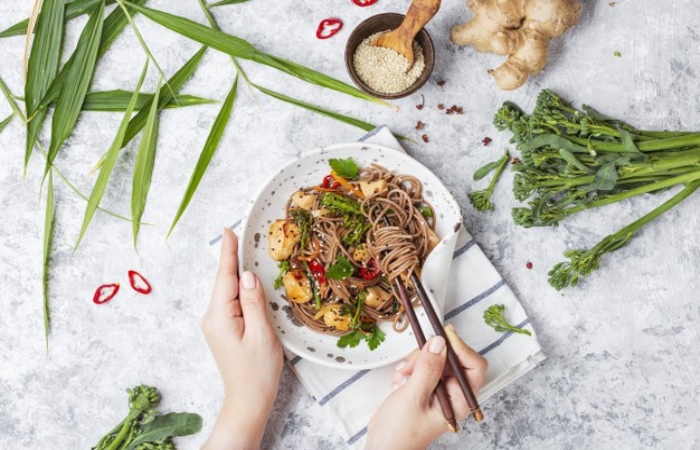
Directions to make Sesame Soba Noodles
- Heat an enormous water pot to the point of boiling and cook the noodles for 4-5 minutes or just until delicate, blending every so often, so the noodles won’t bunch. Channel in a colander and wash well under virus water, throwing to eliminate thickener.
- While the noodles in a medium bowl are cooking, mix the soy sauce, sesame oil, rice vinegar, sugar, and dark pepper. Put in a safe spot.
- Heat a massive skillet over medium-high warmth. Include the canola oil and warmth until gleaming at that point, include the slashed green onions. Cook, blending, for 15 to 30 seconds or until fragrant.
- Include the soy and sesame blend and cook for 30 seconds; add the noodles and throw until the noodles warmed through. Also, include the rest of the minced green onion and half of the sesame seeds. Enhancement with the rest of the roots and serve warm or at room temperature.
Also, read: Kombucha-Health benefits, Risks & Types of Kombucha Tea
Related posts
Trending Posts
Clinique Moisturizer-The best face moisturizers from Clinique
Clinique moisturizer – Description The Clinique moisturizer-“Drastically Extraordinary Saturating Moisturizer ” has an improved equation that fundamentally fortifies skin’s dampness…
Novex DS Tablet: Uses, Dosage, Side Effects – WHBT
About Novex DS Tablet This Novex DS tablet is a particular estrogen receptor modulator, otherwise called SERM. It is essentially…

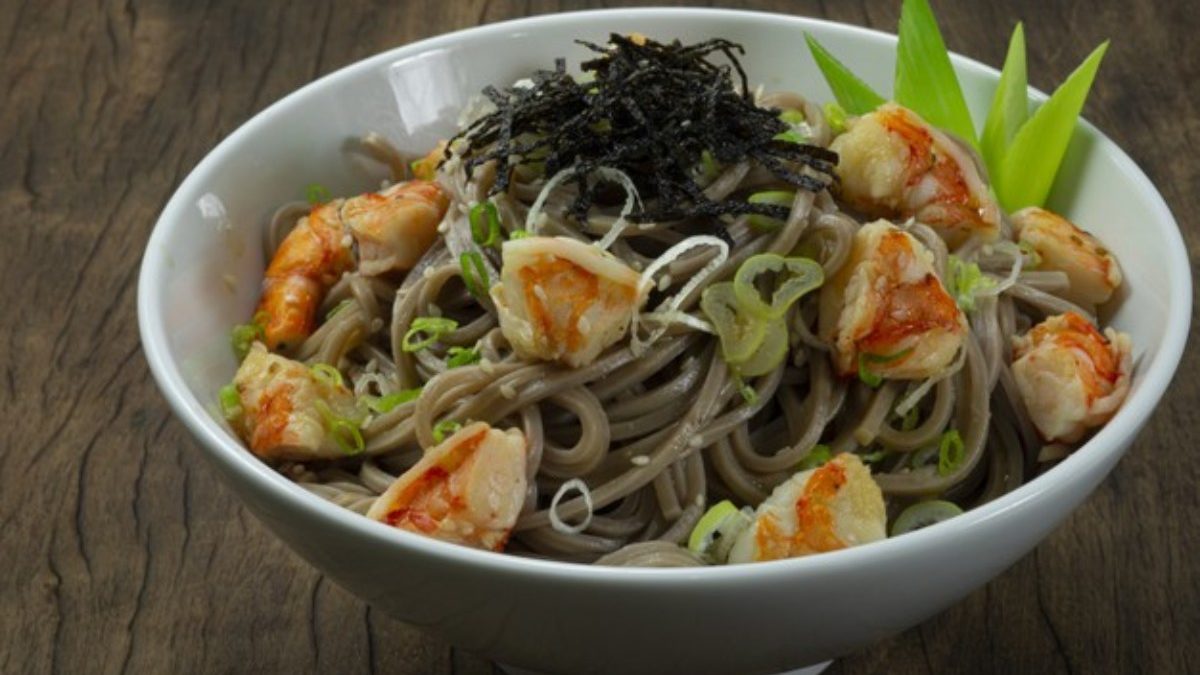




Review Soba Noodles-9 Brilliant Soba Dishes, Sesame Soba Noodles.